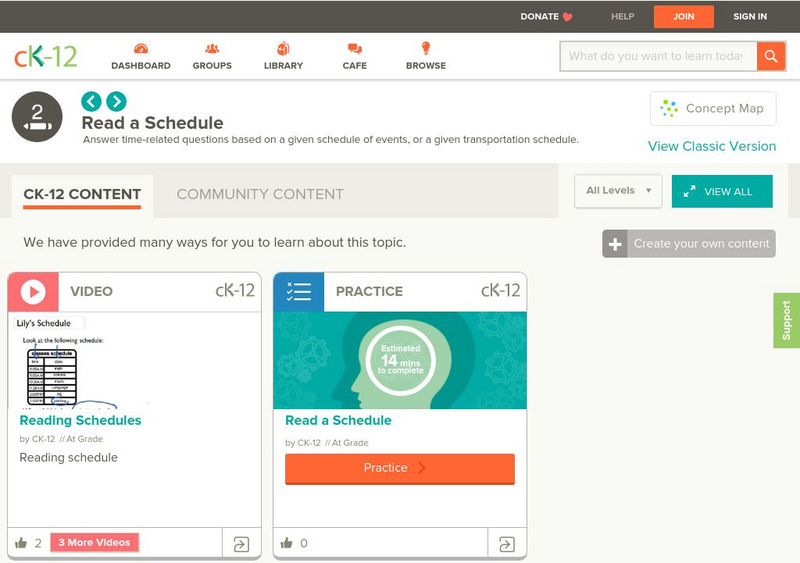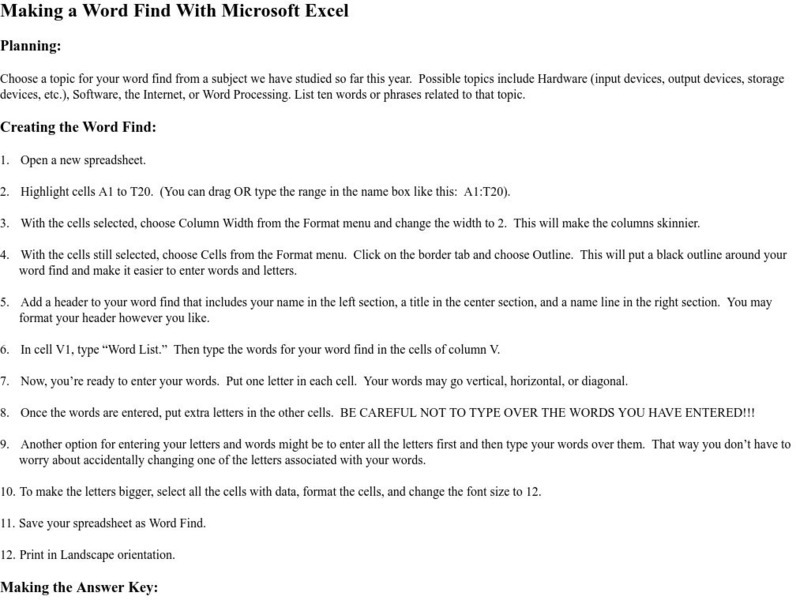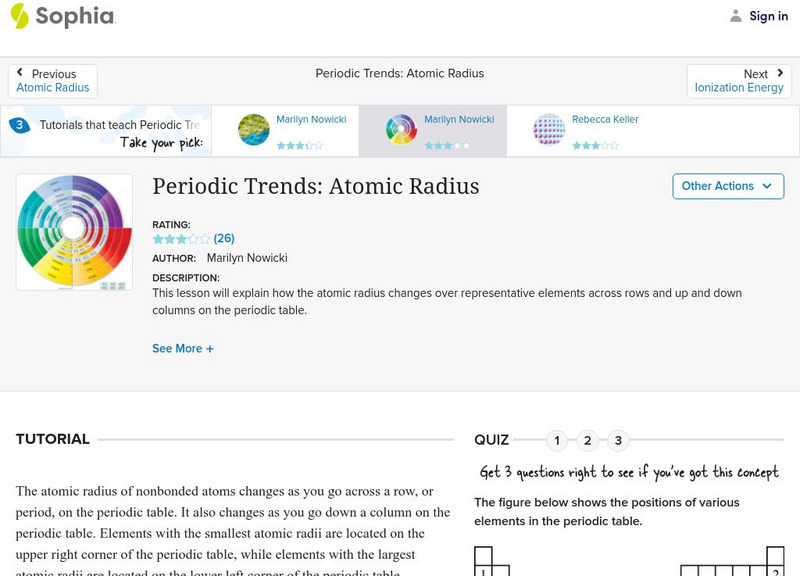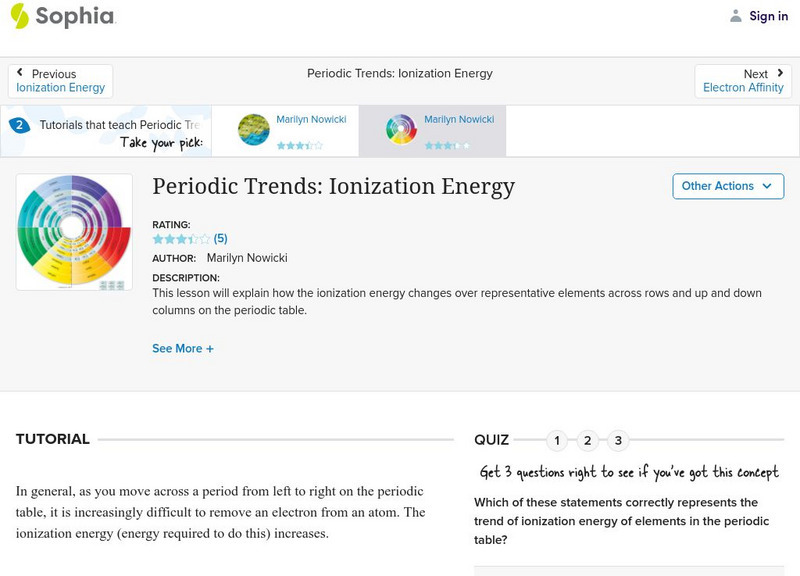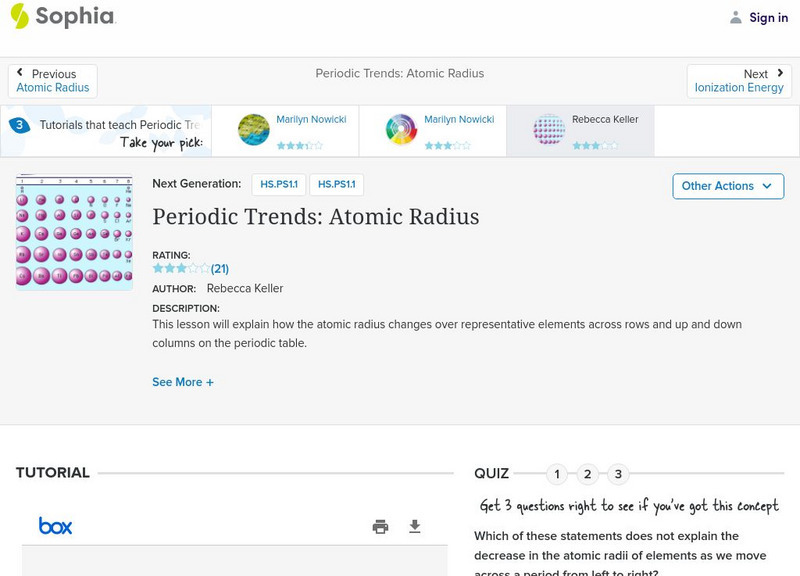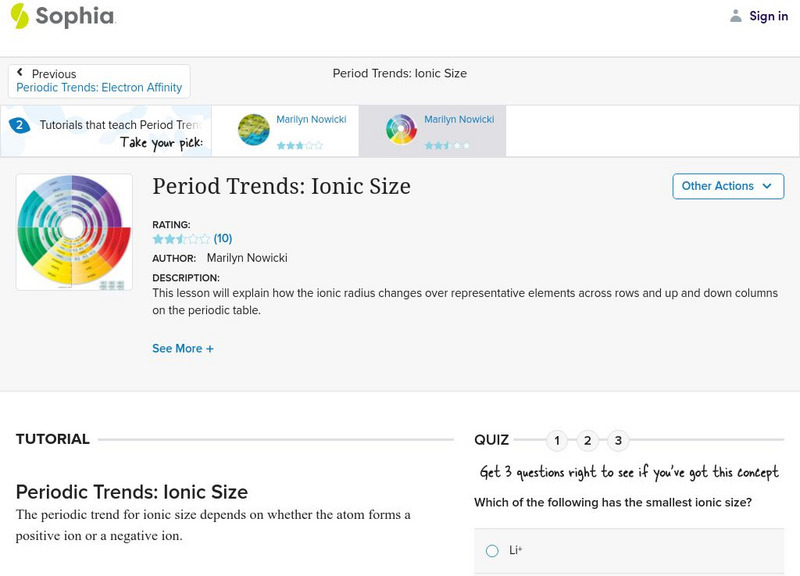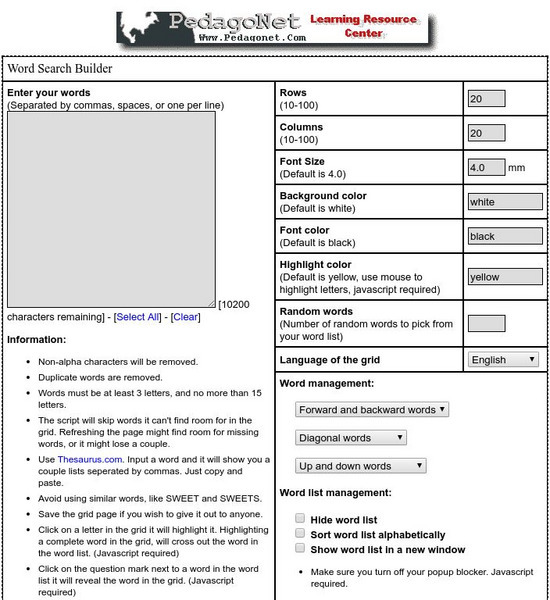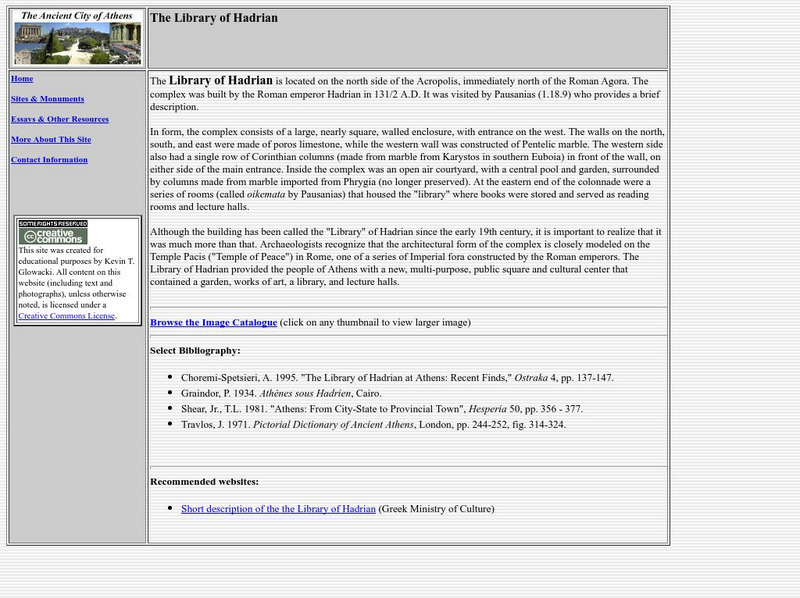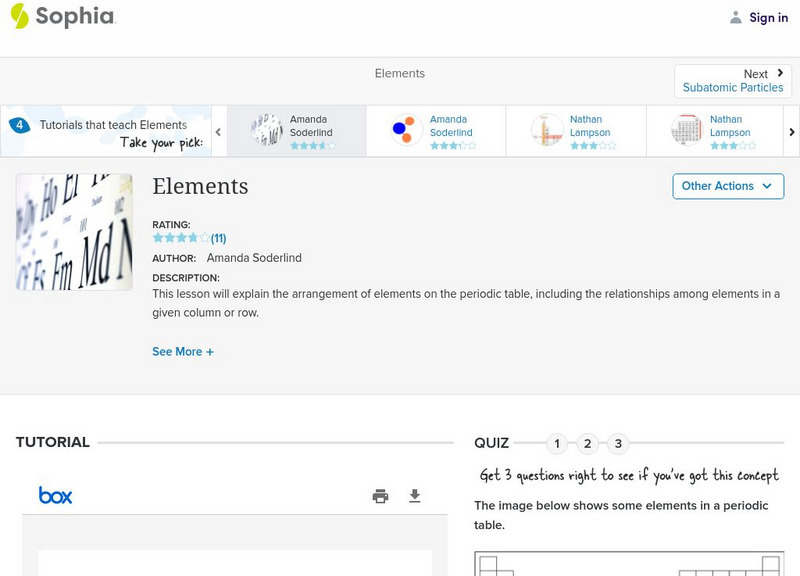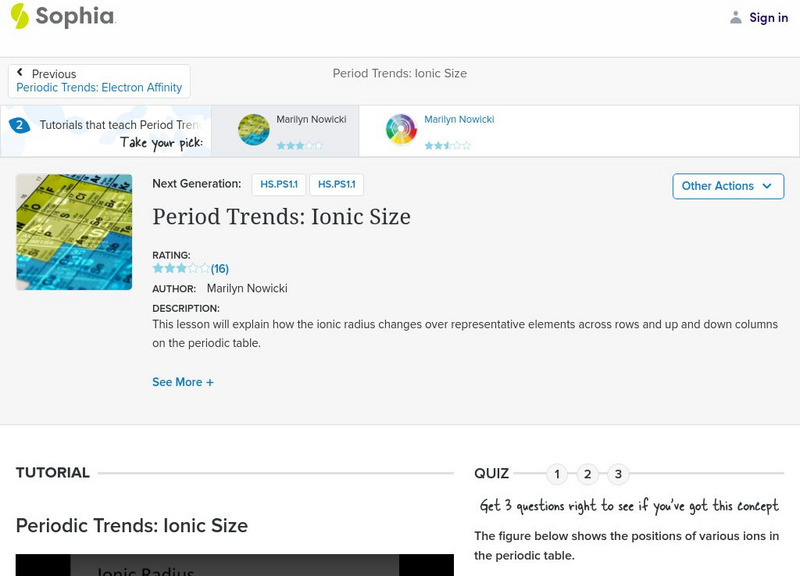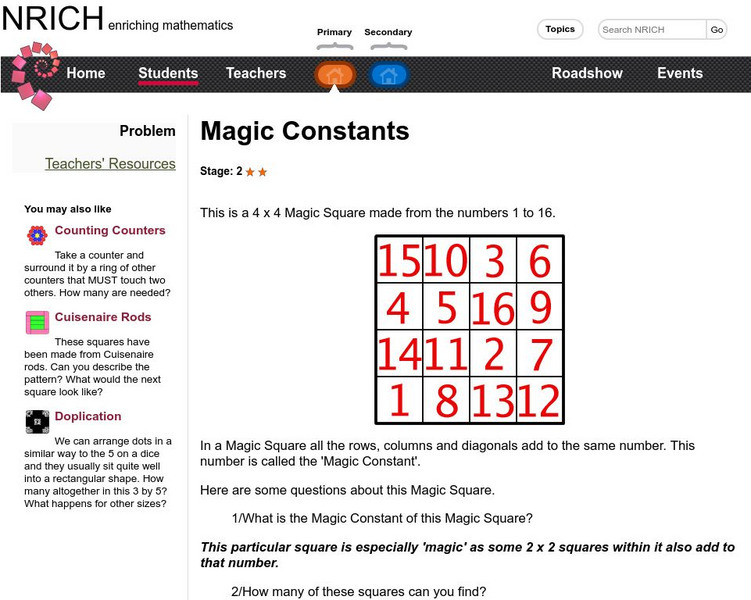Math Is Fun
Math Is Fun: Symmetry Jigsaws
Assemble jigsaw puzzles of items in nature, engineering, math, and art that display symmetry. You can customize a puzzle's rows, columns, and piece shape to make the jigsaw challenging or simple.
CK-12 Foundation
Ck 12: Elem Math: Reading Schedules
[Free Registration/Login may be required to access all resource tools.] The video describes how to read a schedule to determine specific information using the relationship of the rows and the columns. The video is followed by a series of...
Other
Making a Word Find With Microsoft Excel
Teachers and students can create a word find using Excel. It will help them learn to manipulate columns and rows and format and lock cells. This plan is based upon 10 word or phrases on any topic.
Sophia Learning
Sophia: Periodic Trends: Atomic Radius: Lesson 3
This lesson will explain how the atomic radius changes over representative elements across rows and up and down columns on the periodic table. It is 3 of 3 in the series titled "Periodic Trends: Atomic Radius."
Sophia Learning
Sophia: Periodic Trends: Ionization Energy: Lesson 3
This lesson will explain how the ionization energy changes over representative elements across rows and up and down columns on the periodic table. It is 3 of 3 in the series titled "Periodic Trends: Ionization Energy."
Chem4kids
Chem4 Kids: Families Stick Together
Beyond columns and rows, the periodic table groups elements according to families. Identify the families present on the table with this overview.
Sophia Learning
Sophia: Periodic Trends: Atomic Radius: Lesson 2
This lesson will explain how the atomic radius changes over representative elements across rows and up and down columns on the periodic table. It is 2 of 3 in the series titled "Periodic Trends: Atomic Radius."
Sophia Learning
Sophia: Period Trends: Ionic Size: Lesson 3
This lesson will explain how the ionic radius changes over representative elements across rows and up and down columns on the periodic table. It is 3 of 3 in the series titled "Period Trends: Ionic Size."
Math Is Fun
Math Is Fun: Multiply Blocks
An array of chocolate squares is pictured and students must multiply the number of rows by the number of columns and click on the product in the table shown.
Other
Pedago Net: Word Search Builder
Facilitates creation of word-search puzzles. Flexible format provides for 10 to 100 rows and 10 to 100 columns. Features 15 languages!
Other
Function X: Microsoft Excel Tutorial
This site offers tutorials and examples on how to use Microsoft Excel applications and experiment with it.
Louisiana Department of Education
Louisiana Doe: Louisiana Believes: Eureka Math Parent Guide: Foundations of Multiplication and Division
A guide to support parents as they work with their students in the foundations of multiplication and division.
Other
The Stoa Consortium: The Library of Hadrian
The Library of Hadrian is located on the north side of the Acropolis, immediately north of the Roman Agora. The complex was built by the Roman emperor Hadrian in 131/2 A.D. It was visited by Pausanias (1.18.9) who provides a brief...
University of South Florida
Fcat Express: Semantic Feature Analysis Worksheet [Pdf]
This is a worksheet in a pdf format on Semantic Feature Analysis. The worksheet, or matrix, is divided into boxes in three rows with four columns across.
Other
Allmath.com: Magic Squares Game
Magic squares have been a fascinating topic in mathematics for centuries. They are formed by filling in all the squares with the numbers starting from one so that the sum of all rows, columns, and diagonals is the same. Instructions are...
Sophia Learning
Sophia: Elements: Lesson 4
This lesson will explain the arrangement of elements on the periodic table, including the relationships among elements in a given column or row. It is 4 of 4 in the series titled "Elements."
Sophia Learning
Sophia: Elements: Lesson 1
This lesson will explain the arrangement of elements on the periodic table, including the relationships among elements in a given column or row. It is 1 of 4 in the series titled "Elements."
Sophia Learning
Sophia: Periodic Trends: Atomic Radius: Lesson 1
This lesson will explain how the atomic radius changes over representative elements across rows and up and down columns on the periodic table. It is 1 of 3 in the series titled "Periodic Trends: Atomic Radius."
Sophia Learning
Sophia: Period Trends: Ionic Size: Lesson 1
This lesson will explain how the ionic radius changes over representative elements across rows and up and down columns on the periodic table. It is 1 of 3 in the series titled "Period Trends: Ionic Size."
Sophia Learning
Sophia: Periodic Trends: Electron Affinity: Lesson 3
This lesson will explain how the electron affinity changes over representative elements across rows and up and down columns on the periodic table. It is 3 of 3 in the series titled "Periodic Trends: Electron Affinity."
Sophia Learning
Sophia: Elements: Lesson 2
This lesson will explain the arrangement of elements on the periodic table, including the relationships among elements in a given column or row. It is 2 of 4 in the series titled "Elements."
Other
Websudoku
A fun puzzler to get any mind thinking logically! Try many levels of puzzles using the following rules: "Enter digits from 1 to 9 into the blank spaces. Every row must contain one of each digit. So must every column, as must every 3x3...
University of Cambridge
University of Cambridge: Nrich: Three by Three
Push your problem-solving skills to the limit. Arrange 3 red, 3 blue and 3 yellow counters into a three-by-three square grid, so that there is only one of each color in every row and every column.
University of Cambridge
University of Cambridge: Nrich: Magic Squares
In a Magic Square all the rows, columns and diagonals add to the same number. This number is called the Magic Constant. Learn math fundamentals visually and have fun at the same time.
Other popular searches
- Rows and Columns Charts
- Graphs Rows and Columns
- Counting Rows and Columns
- Seeing Rows and Columns
- Symbols in Rows and Columns
- Rows and Columns Geometry
- All Rows/columns Are the Same
- Table Rows and Columns
- Rows Columns Diagonals
- Columns and Rows

